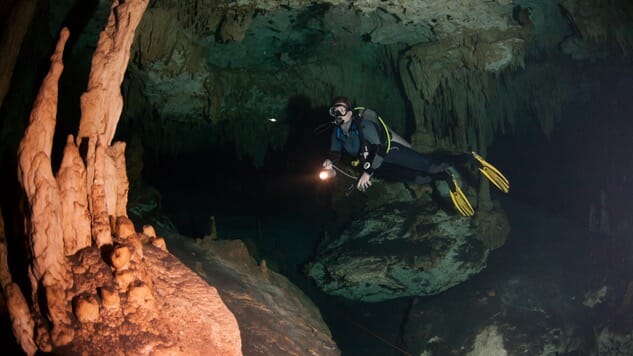deGeneration X: Cave Diving in the Riviera Maya

At the not-so-ripe age of 39, I finally got my PADI dive certification in Taganga, Colombia, and proceeded to dive 40 more times over the next two years. These aquatic adventures included swimming alongside giant manta rays at Nusa Lembongan (Indonesia), through a pack of menacing sharks at Sipadan (Malaysia), with large sea turtles near Roatan Island (Honduras) and down the surreal Blue Hole off the coast of Belize. With such an emphasis on an activity I wanted to do my entire life, it sounds like I became an instant scuba junkie, but I actually came to think diving is a bit overrated. Not a popular sentiment I agree, but I usually don’t see that much more at 120 feet with an oxygen tank than I do at 30 feet with a mask and snorkel. That said, a boat-less dive in Tulum completely blew me away, and the water had little-to-no visible fish.
When it comes to pre-Columbian Mexico, most people think of the Aztecs since their former capital is now Mexico City, but the Maya occupied southern parts of the country that included the Yucatan Peninsula. The most iconic Mayan ruin is El Castillo temple in Chichen Itza, while backpacker-friendly Tulum boasts ruins directly on its white-sand Caribbean beaches. Though not as touristy as Cancun, Cozumel and Playa del Carmen to the north, Tulum arguably outshines them all with beachfront archeology, alluring blue waters and outstanding restaurants like Hartwood and Gitano. The Yucatan also boasts numerous underwater cave systems called cenotes (pronounced “say-no-tayes”) that divers can explore. I booked one such adventure with an Australian-raised Slovokian divemaster named Tomas Kuzela.
“I’m taking you to Dos Ojos,” said Kuzela as he picked me up outside a local hostel. I was the only diver who signed up that day so it was just the two of us. “The name means ‘two eyes’ in Spanish. Are you claustrophobic?”
“Not at all,” I said.
“Good,” the divemaster continued. “It can get cramped in there, and for parts of the system, you will be completely surrounded. You will not be able to surface to get air if your equipment malfunctions or you start to panic. For this reason, you need to stay close to me the entire time.”
“This sounds safe,” I thought to myself.
Cenotes—a mid-19th century term derived from the Maya word “ts’onot”—are natural sinkholes in which limestone bedrock collapsed and exposed a water-filled cave system below. The Yucatan Peninsula contains many such systems, and Dos Ojos is one of the longest and most famous. Exploration of Dos Ojos started 30 years ago, and the Quintana Roo Speleological Survey reported in 2014 that it contains at least 30 sinkhole entrances and stretches more than 51 miles. Per the survey’s analysis of 101 local cenotes, Dos Ojos is the fourth longest, with Sistema Ox Bel Ha leading the pack with nearly 168 miles of caverns. As far as depth, Dos Ojo is the known leader with an area called The Pit stretching 390 feet down.
The namesake Dos Ojos are the Blue Eye and Black Eye whose entrances, as you might have guessed, look like a pair of eyes from an aerial view. For the more adventurous diver, the Black Eye offers a sensory-deprived adventure through pitch-black caves that require portable lights to navigate. Kuzela, however, took me into the Blue Eye where divers swim through turquoise-blue freshwater filled with majestic stalagmite and stalactite formations. At one part of the system, divers can also emerge from the water into a bat cave. The Maya, who settled around these sacred wells, believed the cenotes were entrances to the Xibalba underworld where they could commune with their gods.
“We will do two dives today,” said Kuzela after arriving at the Blue Eye, which is a short drive north of Tulum. “I brought food and drinks, so we will have lunch between the dives.”
I noticed his dive gear included two oxygen tanks.
“You dive with two tanks?”
-

-

-

-

-

-

-

-

-

-

-

-

-

-

-

-

-

-

-

-

-

-

-

-

-

-

-

-

-

-

-

-

-

-

-

-

-

-

-

-








































